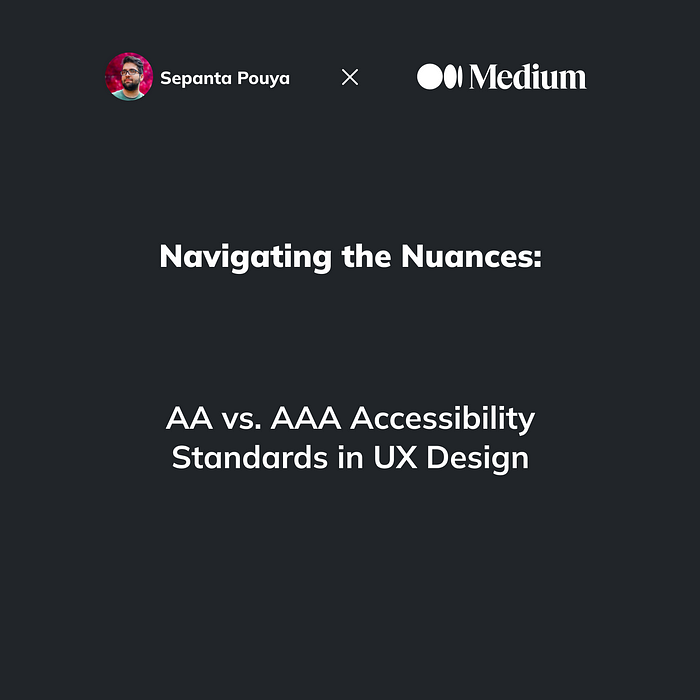Navigating the Nuances: AA vs. AAA Accessibility Standards in UX Design

In the dynamic world of User Experience (UX) design, accessibility isn’t just a buzzword — it’s a crucial framework that ensures our digital creations are usable by everyone, including people with disabilities. As UX designers, we’re not just artists or technicians; we’re also advocates for inclusivity. But when it comes to accessibility standards, things can get a bit murky. Have you ever found yourself puzzled over the difference between AA and AAA compliance? You’re not alone. Let’s demystify these standards together, in a way that’s as engaging as the designs we dream up.
The Foundation: Understanding WCAG
Before we dive into the differences between AA and AAA, let’s set the stage with the Web Content Accessibility Guidelines (WCAG). Think of WCAG as the holy grail of accessibility standards. Developed by the World Wide Web Consortium (W3C), these guidelines are our roadmap to creating more accessible digital spaces.
WCAG outlines how to make web content more accessible to people with a wide range of disabilities, including visual, auditory, physical, speech, cognitive, language, learning, and neurological disabilities. The guidelines are divided into three levels of conformance: A (the minimum level), AA (the standard level), and AAA (the optimal level).
AA: The Standard Compliance
AA compliance is like the goldilocks zone of accessibility. It’s not just the baseline; it’s the standard many organizations strive to meet. AA compliance means your design is accessible to a wider audience without drastically altering your content or design framework. This level addresses the most common barriers for disabled users, including:
- Contrast Ratios: Ensuring text stands out against its background, making it readable for users with visual impairments.
- Navigable Content: Making all functionality available from a keyboard for those who can’t use a mouse.
- Readable Texts: Using clear fonts and providing alternatives for media.
AA standards push us to design with empathy, challenging us to consider how someone with limited vision or hearing might experience our digital environments.
AAA: The Pinnacle of Accessibility
AAA compliance is like the Mount Everest of accessibility standards. It’s challenging to achieve but represents the pinnacle of inclusivity. This level includes all the criteria of A and AA, with additional requirements that make content accessible to the fullest extent possible. Some of these include:
- Enhanced Contrast: Even higher contrast ratios than AA, making text readable in more challenging visual conditions.
- More Navigable Content: Offering even more ways to help users navigate, find content, and determine where they are.
- Live Audio Content Alternatives: Providing alternatives for live audio content in synchronized media.
AAA compliance often requires significant changes to design and content, making it a less common target for most organizations. However, striving for elements of AAA where possible can significantly enhance the user experience for people with disabilities.
Knowing the Difference as a UX Designer
As UX designers, understanding the distinction between AA and AAA is crucial, but knowing how to apply these standards is where the magic happens. Here’s how you can make a difference:
- Start with Empathy: Put yourself in the shoes of users with disabilities. Use accessibility tools and simulators to experience your designs from their perspective.
- Educate Your Team: Share your knowledge about AA and AAA standards with your team. Accessibility is a team effort.
- Aim for AA, Aspire for AAA: While AA compliance should be your baseline, incorporate AAA elements where feasible to elevate your designs.
Conclusion: Embracing Accessibility in UX Design
Accessibility isn’t just about compliance; it’s about creating digital experiences that are inclusive and welcoming to all. By understanding and implementing AA and AAA standards, we as UX designers can lead the charge in building a more accessible digital world. Let’s not just design for the majority; let’s design for everyone. Because in the end, accessibility enriches our designs, making them not only usable but also universally appreciated.
This exploration into AA and AAA accessibility standards is just the beginning. As UX designers, our journey towards inclusivity is ongoing, filled with learning, empathy, and innovation. Let’s continue to share our experiences, challenges, and successes in making the digital world accessible to all. Because when we design with everyone in mind, we create experiences that truly matter.
